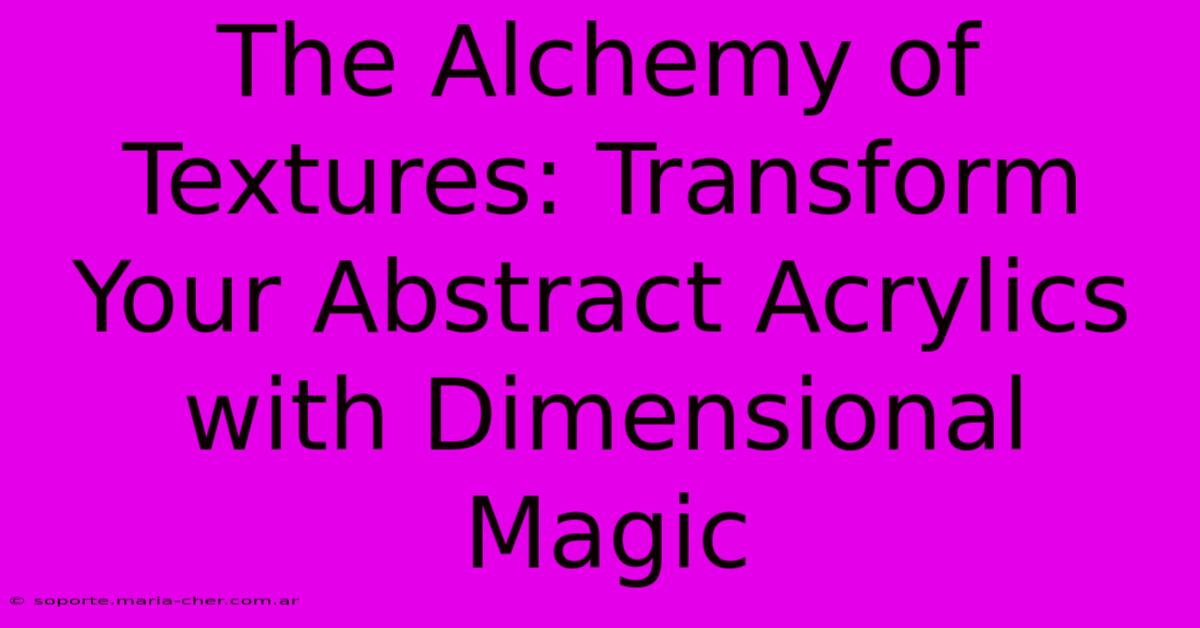The Alchemy Of Textures: Transform Your Abstract Acrylics With Dimensional Magic

Table of Contents
The Alchemy of Textures: Transform Your Abstract Acrylics with Dimensional Magic
Abstract acrylic painting offers a fantastic playground for creativity, but taking your artwork from flat to phenomenal involves mastering the alchemy of texture. Adding dimension breathes life into your canvases, transforming a simple painting into a truly captivating experience. This guide delves into various techniques to elevate your abstract acrylics with exciting textural elements.
Understanding the Power of Texture in Abstract Art
Texture isn't just about visual interest; it's about adding another layer of sensory experience to your artwork. A rough, impasto surface invites the viewer to touch (in their imagination, at least!), while a smooth, polished finish creates a different kind of visual intrigue. The interplay of textures can guide the eye, create focal points, and enhance the overall emotional impact of your abstract piece.
Why Texture Matters for Abstract Acrylics
- Depth and Dimension: Texture creates the illusion of depth, preventing your artwork from looking flat and lifeless.
- Visual Interest: Varying textures keep the viewer engaged, exploring the subtleties of your creation.
- Emotional Impact: Different textures evoke different feelings. A rough texture might suggest turmoil, while a smooth surface could represent calm.
- Unique Style: Mastering texture allows you to develop a unique artistic voice.
Exploring Diverse Textural Techniques
Let's explore some techniques to add captivating textures to your abstract acrylic paintings:
1. Impasto Technique: Bold and Dramatic
Impasto involves applying thick layers of paint, allowing the brushstrokes or palette knife marks to remain visible. This creates a wonderfully tactile surface, adding depth and dramatic effect. Experiment with different tools like palette knives, brushes, and even your fingers to achieve diverse results.
Pro Tip: Use high-quality acrylics that hold their shape well when thickly applied.
2. Collage: Unexpected Dimensions
Introduce unexpected textures by incorporating collage elements. Think fabric scraps, textured paper, found objects, or even metallic leaf. These elements not only add visual interest but also bring a tactile dimension to your work. Consider the color and texture interplay when choosing your collage materials.
Pro Tip: Use a high-quality acrylic medium to adhere your collage elements securely.
3. Sand and Grit: Raw and Earthy
Adding sand, pumice, or other gritty materials to your acrylic paint creates a raw, earthy texture. Mix these elements directly into the paint, or sprinkle them onto wet paint for a more scattered effect. This technique works wonderfully for creating landscapes or evoking a sense of rawness and energy.
Pro Tip: Experiment with different grits and grain sizes for varied textural effects.
4. Modeling Paste: Sculpting with Paint
Acrylic modeling paste is a versatile medium that can be used to create raised surfaces, textures, and even three-dimensional forms. You can apply it directly to the canvas with a palette knife, creating peaks, valleys, and interesting shapes. After it dries, you can paint over it with acrylics for added color and depth.
Pro Tip: Use modeling paste sparingly, especially on large areas, to avoid cracks as it dries.
5. Crackle Medium: Adding Age and History
Crackle medium creates a beautiful aged, cracked effect, adding an antique feel to your abstract work. Apply it to your canvas before painting, and as it dries, it will crack, revealing layers beneath. This technique works particularly well for adding depth and visual complexity to dark or richly colored paintings.
Enhancing Your Textured Masterpieces
Once you've created your textured masterpiece, consider these finishing touches:
- Varnish: A high-quality varnish protects your textured artwork from damage and enhances its vibrancy.
- Framing: Choose a frame that complements your artwork's texture and style. A deep, textured frame can amplify the dimensional effect.
By experimenting with these techniques and developing your own unique approach, you'll unlock the full potential of texture in your abstract acrylics, transforming your paintings into captivating, three-dimensional experiences. Embrace the alchemy of textures, and let your creativity flow!

Thank you for visiting our website wich cover about The Alchemy Of Textures: Transform Your Abstract Acrylics With Dimensional Magic. We hope the information provided has been useful to you. Feel free to contact us if you have any questions or need further assistance. See you next time and dont miss to bookmark.
Featured Posts
-
Hone Your Craft Budget Flower Centerpieces For Every Occasion
Feb 08, 2025
-
Embrace The Tender Embrace Of The Pink Quartz Birthstone A Tranquil Haven For Your Soul
Feb 08, 2025
-
Dominate The Market With Monster Signs The Ultimate Marketing Weapon
Feb 08, 2025
-
Eucalyptus Sanctuary Fresh Leaves To Transform Your Home And Mind
Feb 08, 2025
-
Unlock The Power Of Digital Dentistry Dentrix Ascend Live 3 Unveiled
Feb 08, 2025
